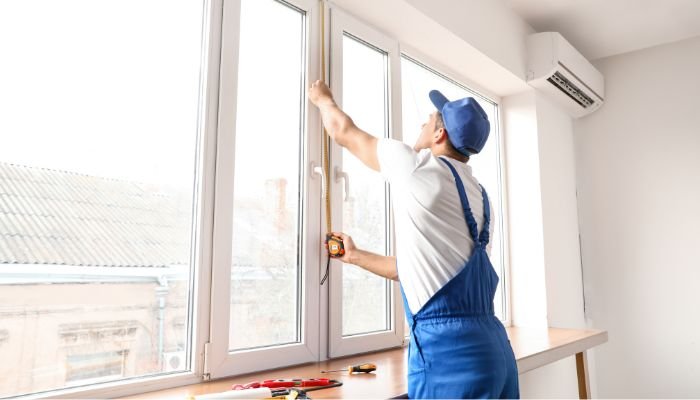New Construction windows vs Replacement windows

Are you in the market for new windows but need to decide whether to go with new construction or replacement windows?
This article will discuss the differences between the two options, from installation methods to cost factors. We’ll explore the pros and cons of each type of window and the best uses for new construction and replacement windows.
Understanding the Difference between New Construction Windows and Replacement Windows
Regarding choosing between new construction windows and replacement windows, it’s crucial to understand the fundamental differences and unique advantages each type offers in terms of installation methods, performance, and energy efficiency.
New construction windows are typically installed in brand-new homes or during major renovations, involving the removal of the existing window frame to install the window directly into the studs of the house. This type of installation allows for more customization in terms of size and style but can be more labor-intensive. On the other hand, replacement windows are designed to fit into existing window openings, making them a popular choice for homeowners looking to upgrade their windows without major structural changes. They often come with features such as double or triple-pane glass for better insulation, low-emissivity coatings to reduce heat transfer, and argon gas fillings to enhance energy efficiency.
What are New Construction Windows?
New construction windows are specifically designed for installation in new structures or during major renovations. These windows typically feature nailing flanges and are integrated into the framing of the building, providing superior performance and durability.
When installing new construction windows, it is essential to ensure that the opening is properly sized and prepared to accommodate their specific requirements. Framing considerations play a crucial role in this process, as the window must be securely attached to the frame to prevent air leakage and ensure efficient insulation.
The performance benefits of new construction windows extend beyond just energy efficiency. These windows offer enhanced security features, improved sound insulation, and increased overall value to the property. By investing in high-quality new construction windows, homeowners can enjoy long-term savings on energy costs and a more comfortable indoor environment.
How are New Construction Windows Installed?
Installing new construction windows involves:
- Carefully integrating them into the building’s structure by securing them to the framing
- Ensuring proper alignment with the studs
- Finishing with exterior cladding and trim for a weather-tight seal
Regarding framing techniques, it is crucial to measure and cut the opening precisely to accommodate the size of the new window. The rough opening should be larger than the window frame to allow for adjustments. Once the window is positioned, it is vital to anchor it securely to the framing members with screws or nails, ensuring stability and support.
A moisture barrier should be installed around the window for the exterior cladding application to prevent water infiltration. This barrier helps protect the structure from potential damage caused by water seepage. The cladding material, whether vinyl, aluminum, or another option, must be installed precisely to create a seamless protective layer.
Trim plays a crucial role in enhancing the window’s visual appeal, sealing gaps, and preventing air leakage. Properly installed trim adds a decorative finish while serving as a barrier against moisture and drafts.
What are the Pros and Cons of New Construction Windows?
New construction windows offer superior energy efficiency, a wide range of design options, and the ability to address specific framing issues, making them ideal for new builds or extensive remodeling projects.
One key advantage of these windows is their ability to enhance a property’s energy efficiency. By incorporating advanced insulation technologies and multiple panes of glass, new construction windows help reduce heat loss and minimize air infiltration.
The design flexibility they offer allows homeowners to customize their windows according to their preferences, whether it’s choosing the frame material, color, or style. This adaptability makes them versatile for various architectural styles and aesthetic preferences.
Despite these benefits, it’s important to note that new construction windows may require more extensive installation compared to replacement windows, sometimes involving alterations to the existing structure. The industry jargon surrounding window specifications and performance ratings can be overwhelming for consumers, making it essential to understand terms like U-factor, SHGC, and VT when selecting the most suitable windows for a project.

What are the Pros and Cons of Replacement Windows?
Replacement windows are designed to provide better insulation than older models, helping homeowners reduce energy costs and maintain a comfortable indoor environment. With advancements in technology, these windows are now more accessible than ever, with many options found in both physical stores and online platforms.
The installation techniques for replacement windows are diverse, allowing them to seamlessly integrate into homes with various exterior cladding materials such as vinyl, wood, or fiber cement. This versatility will enable homeowners to choose windows that complement their exterior design.
Cost Comparison:
When evaluating the cost of new construction windows versus replacement windows, factors such as design flexibility, overall project scope, and specific installation practices play a significant role in determining the most cost-effective and efficient choice for a particular construction or renovation project.
The project complexity can differ significantly based on whether you opt for new construction or replacement windows. New construction windows require the removal of existing window frames and, in some cases, adjustments to the wall structure, adding to the complexity and overall cost of the project.
Regarding installation methodologies, new construction windows are usually installed during a property’s initial build phase, which can be more streamlined and integrated into the overall construction process. In contrast, replacement windows involve removing the old units and fitting the new ones into the existing openings, which may lead to higher labor costs and potential structural adjustments.
Factors that Affect the Cost of New Construction Windows
The cost of new construction windows is influenced by factors such as the presence of attachment fins for secure installation, the desired level of energy efficiency, and the condition of the existing wall studs, all of which contribute to the overall project expenses.
Attachment fins are crucial for ensuring the proper installation of new construction windows. These fins provide a secure mounting point and help prevent air or water leaks, which can impact the windows’ overall durability and performance.
Energy efficiency is another key consideration when choosing windows. Opting for windows with high energy efficiency ratings can lead to long-term cost savings on heating and cooling bills. The state of the wall studs in the existing structure plays a significant role in determining the final project costs. Weak or damaged studs may require reinforcement or replacement, adding to the overall expenses.
Factors that Affect the Cost of Replacement Windows
The cost of replacement windows varies based on factors like the type of exterior cladding involved, the extent of a total remodel versus a partial replacement, and the complexity of adapting to existing rough openings. These factors impact the overall budget for the window replacement project.
Choosing the suitable exterior cladding for replacement windows is crucial as it affects the aesthetic appeal and maintenance requirements over time. Additionally, addressing the extent of the remodel work needed can significantly alter the cost implications. From a practical standpoint, dealing with rough openings can present unique challenges, necessitating precise measurements and custom fitting to ensure a seamless installation.
Best Uses for New Construction Windows and Replacement Windows
Understanding the best applications for new construction windows and replacement windows involves considering the structural integrity of the building, the extent of remodeling or additions planned, and the condition of existing walls, especially when addressing damaged or deteriorating surfaces for optimal window performance and longevity.
When undertaking a renovation project, like adding a sunroom or expanding a living space, selecting the right replacement windows can dramatically enhance the area’s aesthetics and functionality. By incorporating modern energy-efficient features into the new windows, homeowners can not only elevate the overall look of their home but also improve its insulation and energy efficiency, leading to cost savings in the long run. It is crucial to ensure that any structural modifications align with the specific requirements of the new windows, guaranteeing seamless integration and long-lasting performance.
When to Choose New Construction Windows
Opting for new construction windows is advisable when the project involves detachable flanges for efficient installation, the need to integrate seamlessly with the perimeter of the wall system, and the desire for a durable and weather-resistant solution for long-term performance.
Detachable flanges play a crucial role in simplifying the window installation process. They enable swift and hassle-free mounting within the construction framework. This feature ensures that the windows can be securely fixed in place, enhancing both the structural integrity and the aesthetic appeal of the property.
The compatibility of these windows with the wall perimeter facilitates a seamless blend with the overall architectural design, creating a cohesive and visually appealing exterior. This integration enhances the building’s overall appearance and improves energy efficiency by reducing air leakage and heat loss.
The structural advantages of new construction windows contribute to a robust and weatherproof window system that can withstand harsh environmental conditions over time, ensuring long-lasting performance and minimal maintenance requirements.
When to Choose Replacement Windows
Choosing replacement windows is ideal when upgrading to insulated glass units (IGUs), utilizing narrow fins for easy insertion on the exterior side, and seeking a cost-effective solution to improve energy efficiency without major structural modifications.
Along with the energy-saving benefits of IGUs, replacement windows with narrow fins provide a seamless installation process, minimizing disruptions to your home. The enhanced energy efficiency contributes to a more comfortable indoor environment. It leads to potential cost savings on utility bills in the long run. Opting for replacement windows that prioritize both performance and affordability can be a wise investment, offering a balance between upfront costs and long-term benefits.
When to Choose Replacement Windows
Choosing replacement windows is ideal when upgrading to insulated glass units (IGUs), utilizing narrow fins for easy insertion on the exterior side, and seeking a cost-effective solution to improve energy efficiency without major structural modifications.
Along with the energy-saving benefits of IGUs, replacement windows with narrow fins provide a seamless installation process, minimizing disruptions to your home. The enhanced energy efficiency contributes to a more comfortable indoor environment. It leads to potential cost savings on utility bills in the long run. Opting for replacement windows that prioritize both performance and affordability can be a wise investment, offering a balance between upfront costs and long-term benefits.

Frequently Asked Questions
What is the difference between new construction windows and replacement windows?
New construction windows are installed in a newly built home or building. In contrast, replacement windows replace existing windows in an older home or building.
What are the pros and cons of new construction windows?
One of the main pros of new construction windows is that they can be customized to fit the specific needs of a new construction project. However, they can be more expensive and require more installation time and labor.
Are there any advantages to choosing replacement windows over new construction windows?
One advantage of replacement windows is that they can be a more cost-effective option for updating a home or building. They also typically require less time and labor to install compared to new construction windows.
Which type of window is best for my home?
This depends on your specific needs and budget. New construction windows may be the best choice if you are building a new home. If you want to update the windows in an older home, replacement windows may be a more practical option.
What is the cost difference between new construction windows and replacement windows?
New construction windows tend to be more expensive due to the customization and labor involved. Replacement windows can vary in cost depending on the type and size of the window, but they are generally more budget-friendly.
In what situations would it be better to choose new construction windows?
New construction windows are ideal for building a new home or adding an addition to an existing home. They are also a good choice if you want to completely change the layout or design of your windows.





